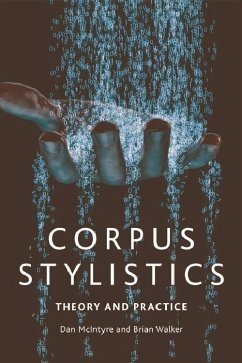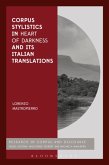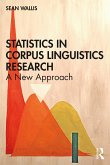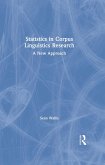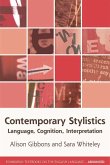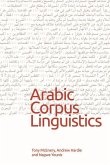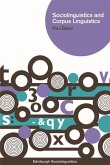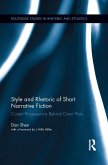Dan McIntyre (Professor of English Language and Univer Linguistics, Brian Walker (University of Huddersfield Research Fellow)
Corpus Stylistics
Theory and Practice
Dan McIntyre (Professor of English Language and Univer Linguistics, Brian Walker (University of Huddersfield Research Fellow)
Corpus Stylistics
Theory and Practice
- Broschiertes Buch
- Merkliste
- Auf die Merkliste
- Bewerten Bewerten
- Teilen
- Produkt teilen
- Produkterinnerung
- Produkterinnerung
This theoretical and practical guide to using corpus linguistic techniques in stylistic analysis focuses on how to use off-the-shelf corpus software, such as AntConc, Wmatrix, and the Brigham Young University (BYU) corpus interface.
Andere Kunden interessierten sich auch für
![Corpus Stylistics in Heart of Darkness and its Italian Translations Corpus Stylistics in Heart of Darkness and its Italian Translations]() Dr Lorenzo Mastropierro (Italy University of Insubria)Corpus Stylistics in Heart of Darkness and its Italian Translations20,99 €
Dr Lorenzo Mastropierro (Italy University of Insubria)Corpus Stylistics in Heart of Darkness and its Italian Translations20,99 €![Statistics in Corpus Linguistics Research Statistics in Corpus Linguistics Research]() Sean WallisStatistics in Corpus Linguistics Research42,99 €
Sean WallisStatistics in Corpus Linguistics Research42,99 €![Statistics in Corpus Linguistics Research Statistics in Corpus Linguistics Research]() Sean WallisStatistics in Corpus Linguistics Research154,99 €
Sean WallisStatistics in Corpus Linguistics Research154,99 €![Contemporary Stylistics Contemporary Stylistics]() Alison Gibbons (Sheffield Hallam University Reader)Contemporary Stylistics33,99 €
Alison Gibbons (Sheffield Hallam University Reader)Contemporary Stylistics33,99 €![Arabic Corpus Linguistics Arabic Corpus Linguistics]() Arabic Corpus Linguistics107,99 €
Arabic Corpus Linguistics107,99 €![Sociolinguistics and Corpus Linguistics Sociolinguistics and Corpus Linguistics]() Paul Baker (Senior Lecturer in the Department of Linguistics and EnSociolinguistics and Corpus Linguistics37,99 €
Paul Baker (Senior Lecturer in the Department of Linguistics and EnSociolinguistics and Corpus Linguistics37,99 €![Style and Rhetoric of Short Narrative Fiction Style and Rhetoric of Short Narrative Fiction]() Dan ShenStyle and Rhetoric of Short Narrative Fiction54,99 €
Dan ShenStyle and Rhetoric of Short Narrative Fiction54,99 €-
-
-
This theoretical and practical guide to using corpus linguistic techniques in stylistic analysis focuses on how to use off-the-shelf corpus software, such as AntConc, Wmatrix, and the Brigham Young University (BYU) corpus interface.
Produktdetails
- Produktdetails
- Verlag: Edinburgh University Press
- Seitenzahl: 376
- Erscheinungstermin: 18. März 2019
- Englisch
- Abmessung: 244mm x 171mm x 27mm
- Gewicht: 666g
- ISBN-13: 9781474413213
- ISBN-10: 1474413218
- Artikelnr.: 53927659
- Herstellerkennzeichnung
- Libri GmbH
- Europaallee 1
- 36244 Bad Hersfeld
- gpsr@libri.de
- Verlag: Edinburgh University Press
- Seitenzahl: 376
- Erscheinungstermin: 18. März 2019
- Englisch
- Abmessung: 244mm x 171mm x 27mm
- Gewicht: 666g
- ISBN-13: 9781474413213
- ISBN-10: 1474413218
- Artikelnr.: 53927659
- Herstellerkennzeichnung
- Libri GmbH
- Europaallee 1
- 36244 Bad Hersfeld
- gpsr@libri.de
Dan McIntyre is Professor of English Language and Linguistics at the University of Huddersfield. Brian Walker is a Research Fellow at the University of Huddersfield.
Acknowledgements; Tables; Figures; Boxes
Chapter 1: Combining corpus linguistics and stylistics
1. Introduction 2. What is a corpus? 3. A brief history of corpus
linguistics 4. The emergence of corpus stylistics and problems with its
definition 5. Style and stylistics 6. Corpus stylistics versus cognitive
stylistics 7. Aims of the book 8. Structure of the book
Chapter 2: Using corpora to support qualitative stylistic analysis
1. Introduction 2. Strolling with intent: an exercise in corpus informed
stylistics 3. Collocation and semantic prosody 4. Case study: irony in
'Aftermyth of war' 5. Conclusion
Chapter 3: Constructing and annotating corpora
1. Introduction 2. Designing a corpus: representativeness and sampling 3.
Building a corpus: collecting and storing data 4. Adding metadata to a
corpus: mark-up and annotation 5. Summary: suggested steps to building a
corpus 6. Case study: investigating the 2000AD comic strip 'Judge Dredd' 7.
Conclusion
Chapter 4: Testing hypotheses and answering research questions
1. Introduction 2. Corpora in stylistics 3. The concept of corpus-based and
corpus-driven linguistics 4. The value of intuition 5. Hypotheses 6.
Objectives and research questions 7. How big was Dickens's vocabulary? 8.
Objectivity in stylistics 9. Case study: Hemingway's authorial style 10.
Conclusion
Chapter 5: Making sense of significance
1. Introduction 2. Vocabulary size 3. Keyness 4. Collocation 5. Case study:
salience and foregrounding in David Peace's 1974 6. Conclusion
Chapter 6: Cognition, character and corpus stylistics
1. Introduction 2. A cognitive stylistic approach to characterisation 3.
Constraints on subtitles 4. Case study: Case study: subtitling and
characterisation in Tinker Tailor Soldier Spy 5. Conclusion
Chapter 7: Pedagogical corpus stylistics
1. Introduction 2. Stylistics in the L2/FL classroom 3. Using corpora in
the classroom 4. Developing corpus activities 5. Case study: from internal
deviation to external norms via Adrian Henri's 'Tonight at Noon' 6.
Conclusion
Chapter 8: Historical corpus stylistics
1. Introduction 2. Studying style diachronically and synchronically 3.
Choosing appropriate corpora and tools 4. Case study: discourse
presentation in Early Modern English 5. Case study: Frequencies and
functions of modal auxiliary verbs in Early Modern English journalism 6.
Conclusion
Chapter 9: Real-world applications for corpus stylistics
1. Introduction 2. The impact of applied stylistics 3. Language Unlocked 4.
Wmatrix 5. Case study: corpora and the self-presentational style of the UK
Green Party 6. Implications of the research 7. Conclusion
Chapter 10: The scope of corpus stylistics
1. Introduction 2. The problem of definition 3. Corpus linguistics and
stylistics: a symbiotic relationship 4. Conclusion
Appendix 1: Corpora for corpus stylistics; Appendix 2: Software for corpus
stylistics; References
Chapter 1: Combining corpus linguistics and stylistics
1. Introduction 2. What is a corpus? 3. A brief history of corpus
linguistics 4. The emergence of corpus stylistics and problems with its
definition 5. Style and stylistics 6. Corpus stylistics versus cognitive
stylistics 7. Aims of the book 8. Structure of the book
Chapter 2: Using corpora to support qualitative stylistic analysis
1. Introduction 2. Strolling with intent: an exercise in corpus informed
stylistics 3. Collocation and semantic prosody 4. Case study: irony in
'Aftermyth of war' 5. Conclusion
Chapter 3: Constructing and annotating corpora
1. Introduction 2. Designing a corpus: representativeness and sampling 3.
Building a corpus: collecting and storing data 4. Adding metadata to a
corpus: mark-up and annotation 5. Summary: suggested steps to building a
corpus 6. Case study: investigating the 2000AD comic strip 'Judge Dredd' 7.
Conclusion
Chapter 4: Testing hypotheses and answering research questions
1. Introduction 2. Corpora in stylistics 3. The concept of corpus-based and
corpus-driven linguistics 4. The value of intuition 5. Hypotheses 6.
Objectives and research questions 7. How big was Dickens's vocabulary? 8.
Objectivity in stylistics 9. Case study: Hemingway's authorial style 10.
Conclusion
Chapter 5: Making sense of significance
1. Introduction 2. Vocabulary size 3. Keyness 4. Collocation 5. Case study:
salience and foregrounding in David Peace's 1974 6. Conclusion
Chapter 6: Cognition, character and corpus stylistics
1. Introduction 2. A cognitive stylistic approach to characterisation 3.
Constraints on subtitles 4. Case study: Case study: subtitling and
characterisation in Tinker Tailor Soldier Spy 5. Conclusion
Chapter 7: Pedagogical corpus stylistics
1. Introduction 2. Stylistics in the L2/FL classroom 3. Using corpora in
the classroom 4. Developing corpus activities 5. Case study: from internal
deviation to external norms via Adrian Henri's 'Tonight at Noon' 6.
Conclusion
Chapter 8: Historical corpus stylistics
1. Introduction 2. Studying style diachronically and synchronically 3.
Choosing appropriate corpora and tools 4. Case study: discourse
presentation in Early Modern English 5. Case study: Frequencies and
functions of modal auxiliary verbs in Early Modern English journalism 6.
Conclusion
Chapter 9: Real-world applications for corpus stylistics
1. Introduction 2. The impact of applied stylistics 3. Language Unlocked 4.
Wmatrix 5. Case study: corpora and the self-presentational style of the UK
Green Party 6. Implications of the research 7. Conclusion
Chapter 10: The scope of corpus stylistics
1. Introduction 2. The problem of definition 3. Corpus linguistics and
stylistics: a symbiotic relationship 4. Conclusion
Appendix 1: Corpora for corpus stylistics; Appendix 2: Software for corpus
stylistics; References
Acknowledgements; Tables; Figures; Boxes
Chapter 1: Combining corpus linguistics and stylistics
1. Introduction 2. What is a corpus? 3. A brief history of corpus
linguistics 4. The emergence of corpus stylistics and problems with its
definition 5. Style and stylistics 6. Corpus stylistics versus cognitive
stylistics 7. Aims of the book 8. Structure of the book
Chapter 2: Using corpora to support qualitative stylistic analysis
1. Introduction 2. Strolling with intent: an exercise in corpus informed
stylistics 3. Collocation and semantic prosody 4. Case study: irony in
'Aftermyth of war' 5. Conclusion
Chapter 3: Constructing and annotating corpora
1. Introduction 2. Designing a corpus: representativeness and sampling 3.
Building a corpus: collecting and storing data 4. Adding metadata to a
corpus: mark-up and annotation 5. Summary: suggested steps to building a
corpus 6. Case study: investigating the 2000AD comic strip 'Judge Dredd' 7.
Conclusion
Chapter 4: Testing hypotheses and answering research questions
1. Introduction 2. Corpora in stylistics 3. The concept of corpus-based and
corpus-driven linguistics 4. The value of intuition 5. Hypotheses 6.
Objectives and research questions 7. How big was Dickens's vocabulary? 8.
Objectivity in stylistics 9. Case study: Hemingway's authorial style 10.
Conclusion
Chapter 5: Making sense of significance
1. Introduction 2. Vocabulary size 3. Keyness 4. Collocation 5. Case study:
salience and foregrounding in David Peace's 1974 6. Conclusion
Chapter 6: Cognition, character and corpus stylistics
1. Introduction 2. A cognitive stylistic approach to characterisation 3.
Constraints on subtitles 4. Case study: Case study: subtitling and
characterisation in Tinker Tailor Soldier Spy 5. Conclusion
Chapter 7: Pedagogical corpus stylistics
1. Introduction 2. Stylistics in the L2/FL classroom 3. Using corpora in
the classroom 4. Developing corpus activities 5. Case study: from internal
deviation to external norms via Adrian Henri's 'Tonight at Noon' 6.
Conclusion
Chapter 8: Historical corpus stylistics
1. Introduction 2. Studying style diachronically and synchronically 3.
Choosing appropriate corpora and tools 4. Case study: discourse
presentation in Early Modern English 5. Case study: Frequencies and
functions of modal auxiliary verbs in Early Modern English journalism 6.
Conclusion
Chapter 9: Real-world applications for corpus stylistics
1. Introduction 2. The impact of applied stylistics 3. Language Unlocked 4.
Wmatrix 5. Case study: corpora and the self-presentational style of the UK
Green Party 6. Implications of the research 7. Conclusion
Chapter 10: The scope of corpus stylistics
1. Introduction 2. The problem of definition 3. Corpus linguistics and
stylistics: a symbiotic relationship 4. Conclusion
Appendix 1: Corpora for corpus stylistics; Appendix 2: Software for corpus
stylistics; References
Chapter 1: Combining corpus linguistics and stylistics
1. Introduction 2. What is a corpus? 3. A brief history of corpus
linguistics 4. The emergence of corpus stylistics and problems with its
definition 5. Style and stylistics 6. Corpus stylistics versus cognitive
stylistics 7. Aims of the book 8. Structure of the book
Chapter 2: Using corpora to support qualitative stylistic analysis
1. Introduction 2. Strolling with intent: an exercise in corpus informed
stylistics 3. Collocation and semantic prosody 4. Case study: irony in
'Aftermyth of war' 5. Conclusion
Chapter 3: Constructing and annotating corpora
1. Introduction 2. Designing a corpus: representativeness and sampling 3.
Building a corpus: collecting and storing data 4. Adding metadata to a
corpus: mark-up and annotation 5. Summary: suggested steps to building a
corpus 6. Case study: investigating the 2000AD comic strip 'Judge Dredd' 7.
Conclusion
Chapter 4: Testing hypotheses and answering research questions
1. Introduction 2. Corpora in stylistics 3. The concept of corpus-based and
corpus-driven linguistics 4. The value of intuition 5. Hypotheses 6.
Objectives and research questions 7. How big was Dickens's vocabulary? 8.
Objectivity in stylistics 9. Case study: Hemingway's authorial style 10.
Conclusion
Chapter 5: Making sense of significance
1. Introduction 2. Vocabulary size 3. Keyness 4. Collocation 5. Case study:
salience and foregrounding in David Peace's 1974 6. Conclusion
Chapter 6: Cognition, character and corpus stylistics
1. Introduction 2. A cognitive stylistic approach to characterisation 3.
Constraints on subtitles 4. Case study: Case study: subtitling and
characterisation in Tinker Tailor Soldier Spy 5. Conclusion
Chapter 7: Pedagogical corpus stylistics
1. Introduction 2. Stylistics in the L2/FL classroom 3. Using corpora in
the classroom 4. Developing corpus activities 5. Case study: from internal
deviation to external norms via Adrian Henri's 'Tonight at Noon' 6.
Conclusion
Chapter 8: Historical corpus stylistics
1. Introduction 2. Studying style diachronically and synchronically 3.
Choosing appropriate corpora and tools 4. Case study: discourse
presentation in Early Modern English 5. Case study: Frequencies and
functions of modal auxiliary verbs in Early Modern English journalism 6.
Conclusion
Chapter 9: Real-world applications for corpus stylistics
1. Introduction 2. The impact of applied stylistics 3. Language Unlocked 4.
Wmatrix 5. Case study: corpora and the self-presentational style of the UK
Green Party 6. Implications of the research 7. Conclusion
Chapter 10: The scope of corpus stylistics
1. Introduction 2. The problem of definition 3. Corpus linguistics and
stylistics: a symbiotic relationship 4. Conclusion
Appendix 1: Corpora for corpus stylistics; Appendix 2: Software for corpus
stylistics; References

